engine Citroen C3 PICASSO DAG 2010.5 1.G Owner's Guide
[x] Cancel search | Manufacturer: CITROEN, Model Year: 2010.5, Model line: C3 PICASSO DAG, Model: Citroen C3 PICASSO DAG 2010.5 1.GPages: 224, PDF Size: 11.08 MB
Page 70 of 224
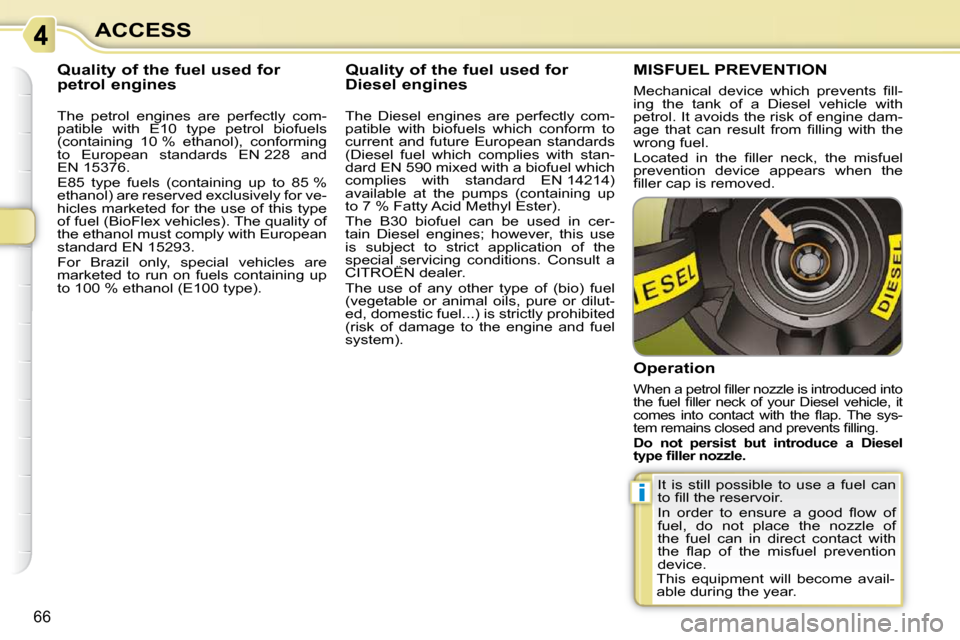
i
66
ACCESS
Quality of the fuel used for
petrol engines
The petrol engines are perfectly com-
patible with E10 type petrol biofuels
(containing 10 % ethanol), conforming
to European standards EN 228 and
EN 15376.
E85 type fuels (containing up to 85 %
ethanol) are reserved exclusively for ve-
hicles marketed for the use of this type
of fuel (BioFlex vehicles). The quality of
the ethanol must comply with European
standard EN 15293.
For Brazil only, special vehicles are
marketed to run on fuels containing up
to 100 % ethanol (E100 type). Quality of the fuel used for
Diesel engines
The Diesel engines are perfectly com-
patible with biofuels which conform to
current and future European standards
(Diesel fuel which complies with stan-
dard EN 590 mixed with a biofuel which
complies with standard EN 14214)
available at the pumps (containing up
to 7 % Fatty Acid Methyl Ester).
The B30 biofuel can be used in cer-
tain Diesel engines; however, this use
is subject to strict application of the
special servicing conditions. Consult a
CITROËN dealer.
The use of any other type of (bio) fuel
(vegetable or animal oils, pure or dilut-
ed, domestic fuel...) is strictly prohibited
(risk of damage to the engine and fuel
system).
MISFUEL PREVENTION
Operation
It is still possible to use a fuel can
�t�o� �fi� �l�l� �t�h�e� �r�e�s�e�r�v�o�i�r�.� �
�I�n� �o�r�d�e�r� �t�o� �e�n�s�u�r�e� �a� �g�o�o�d� �fl� �o�w� �o�f�
fuel, do not place the nozzle of
the fuel can in direct contact with
�t�h�e� �fl� �a�p� �o�f� �t�h�e� �m�i�s�f�u�e�l� �p�r�e�v�e�n�t�i�o�n�
device.
This equipment will become avail-
able during the year.
� �M�e�c�h�a�n�i�c�a�l� �d�e�v�i�c�e� �w�h�i�c�h� �p�r�e�v�e�n�t�s� �fi� �l�l�-
ing the tank of a Diesel vehicle with
petrol. It avoids the risk of engine dam-
�a�g�e� �t�h�a�t� �c�a�n� �r�e�s�u�l�t� �f�r�o�m� �fi� �l�l�i�n�g� �w�i�t�h� �t�h�e�
wrong fuel.
� �L�o�c�a�t�e�d� �i�n� �t�h�e� �fi� �l�l�e�r� �n�e�c�k�,� �t�h�e� �m�i�s�f�u�e�l�
prevention device appears when the
�fi� �l�l�e�r� �c�a�p� �i�s� �r�e�m�o�v�e�d�.�
� �W�h�e�n� �a� �p�e�t�r�o�l� �fi� �l�l�e�r� �n�o�z�z�l�e� �i�s� �i�n�t�r�o�d�u�c�e�d� �i�n�t�o�
�t�h�e� �f�u�e�l� �fi� �l�l�e�r� �n�e�c�k� �o�f� �y�o�u�r� �D�i�e�s�e�l� �v�e�h�i�c�l�e�,� �i�t�
�c�o�m�e�s� �i�n�t�o� �c�o�n�t�a�c�t� �w�i�t�h� �t�h�e� �fl� �a�p�.� �T�h�e� �s�y�s�-
�t�e�m� �r�e�m�a�i�n�s� �c�l�o�s�e�d� �a�n�d� �p�r�e�v�e�n�t�s� �fi� �l�l�i�n�g�.�
Do not persist but introduce a Diesel
�t�y�p�e� �fi� �l�l�e�r� �n�o�z�z�l�e�.
Page 71 of 224

i
66
ACCESS
Quality of the fuel used for
petrol engines
The petrol engines are perfectly com-
patible with E10 type petrol biofuels
(containing 10 % ethanol), conforming
to European standards EN 228 and
EN 15376.
E85 type fuels (containing up to 85 %
ethanol) are reserved exclusively for ve-
hicles marketed for the use of this type
of fuel (BioFlex vehicles). The quality of
the ethanol must comply with European
standard EN 15293.
For Brazil only, special vehicles are
marketed to run on fuels containing up
to 100 % ethanol (E100 type). Quality of the fuel used for
Diesel engines
The Diesel engines are perfectly com-
patible with biofuels which conform to
current and future European standards
(Diesel fuel which complies with stan-
dard EN 590 mixed with a biofuel which
complies with standard EN 14214)
available at the pumps (containing up
to 7 % Fatty Acid Methyl Ester).
The B30 biofuel can be used in cer-
tain Diesel engines; however, this use
is subject to strict application of the
special servicing conditions. Consult a
CITROËN dealer.
The use of any other type of (bio) fuel
(vegetable or animal oils, pure or dilut-
ed, domestic fuel...) is strictly prohibited
(risk of damage to the engine and fuel
system).
MISFUEL PREVENTION
Operation
It is still possible to use a fuel can
�t�o� �fi� �l�l� �t�h�e� �r�e�s�e�r�v�o�i�r�.� �
�I�n� �o�r�d�e�r� �t�o� �e�n�s�u�r�e� �a� �g�o�o�d� �fl� �o�w� �o�f�
fuel, do not place the nozzle of
the fuel can in direct contact with
�t�h�e� �fl� �a�p� �o�f� �t�h�e� �m�i�s�f�u�e�l� �p�r�e�v�e�n�t�i�o�n�
device.
This equipment will become avail-
able during the year.
� �M�e�c�h�a�n�i�c�a�l� �d�e�v�i�c�e� �w�h�i�c�h� �p�r�e�v�e�n�t�s� �fi� �l�l�-
ing the tank of a Diesel vehicle with
petrol. It avoids the risk of engine dam-
�a�g�e� �t�h�a�t� �c�a�n� �r�e�s�u�l�t� �f�r�o�m� �fi� �l�l�i�n�g� �w�i�t�h� �t�h�e�
wrong fuel.
� �L�o�c�a�t�e�d� �i�n� �t�h�e� �fi� �l�l�e�r� �n�e�c�k�,� �t�h�e� �m�i�s�f�u�e�l�
prevention device appears when the
�fi� �l�l�e�r� �c�a�p� �i�s� �r�e�m�o�v�e�d�.�
� �W�h�e�n� �a� �p�e�t�r�o�l� �fi� �l�l�e�r� �n�o�z�z�l�e� �i�s� �i�n�t�r�o�d�u�c�e�d� �i�n�t�o�
�t�h�e� �f�u�e�l� �fi� �l�l�e�r� �n�e�c�k� �o�f� �y�o�u�r� �D�i�e�s�e�l� �v�e�h�i�c�l�e�,� �i�t�
�c�o�m�e�s� �i�n�t�o� �c�o�n�t�a�c�t� �w�i�t�h� �t�h�e� �fl� �a�p�.� �T�h�e� �s�y�s�-
�t�e�m� �r�e�m�a�i�n�s� �c�l�o�s�e�d� �a�n�d� �p�r�e�v�e�n�t�s� �fi� �l�l�i�n�g�.�
Do not persist but introduce a Diesel
�t�y�p�e� �fi� �l�l�e�r� �n�o�z�z�l�e�.
Page 82 of 224
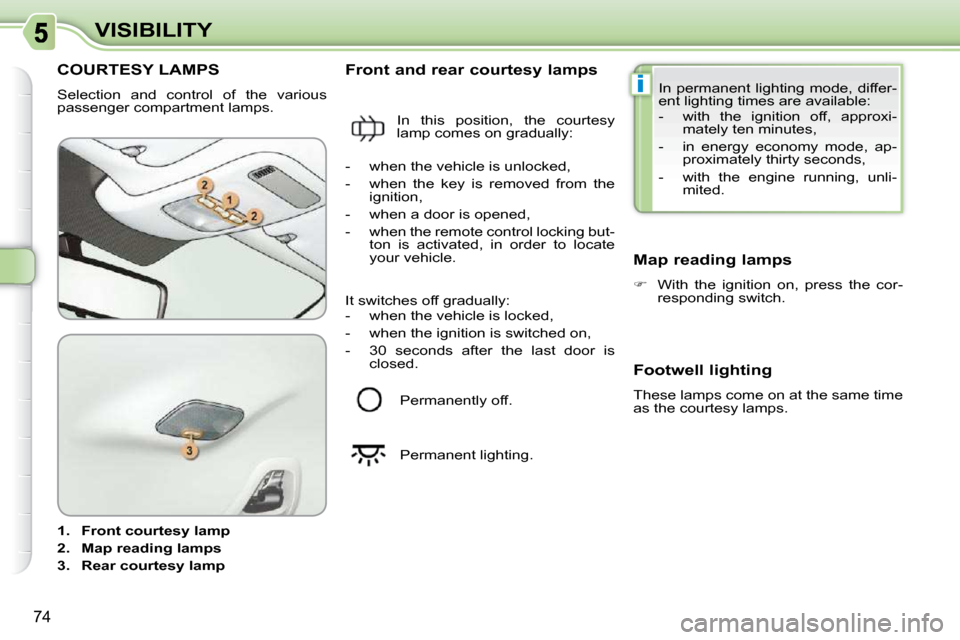
i
74
VISIBILITY
COURTESY LAMPS
Selection and control of the various
passenger compartment lamps.
1. Front courtesy lamp
2. Map reading lamps
3. Rear courtesy lamp Front and rear courtesy lamps
Map reading lamps
� With the ignition on, press the cor-
responding switch. In permanent lighting mode, differ-
ent lighting times are available:
- with the ignition off, approxi-
mately ten minutes,
- in energy economy mode, ap- proximately thirty seconds,
- with the engine running, unli- mited.
In this position, the courtesy
lamp comes on gradually:
Permanently off.
Permanent lighting.
It switches off gradually:
- when the vehicle is locked,
- when the ignition is switched on,
- 30 seconds after the last door is
closed.
- when the vehicle is unlocked,
- when the key is removed from the
ignition,
- when a door is opened,
- when the remote control locking but- ton is activated, in order to locate
your vehicle.
Footwell lighting
These lamps come on at the same time
as the courtesy lamps.
Page 83 of 224
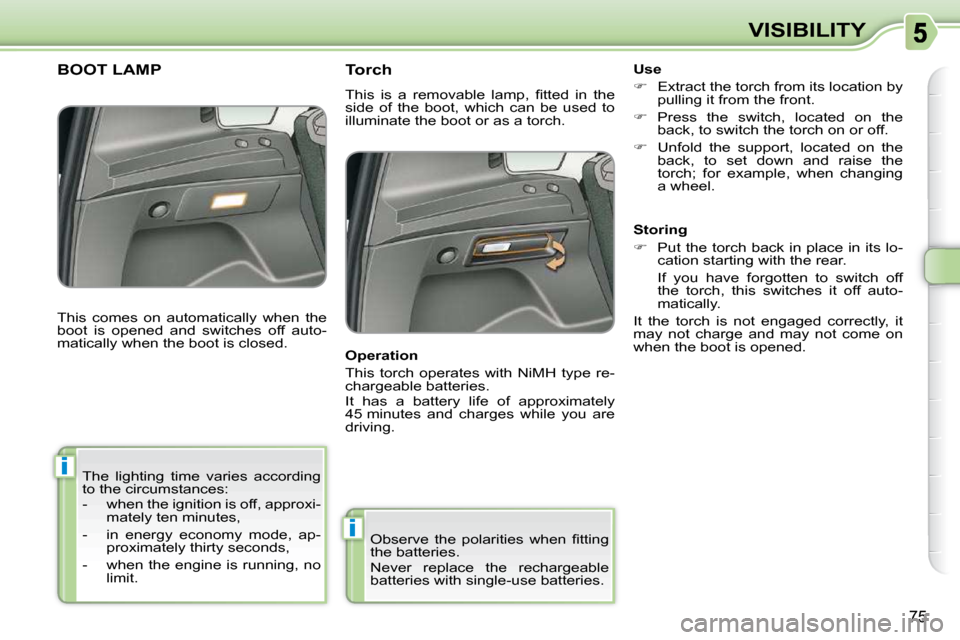
i
i
75
VISIBILITY
The lighting time varies according
to the circumstances:
- when the ignition is off, approxi- mately ten minutes,
- in energy economy mode, ap- proximately thirty seconds,
- when the engine is running, no limit.
This comes on automatically when the
boot is opened and switches off auto-
matically when the boot is closed. Torch
� �T�h�i�s� �i�s� �a� �r�e�m�o�v�a�b�l�e� �l�a�m�p�,� �fi� �t�t�e�d� �i�n� �t�h�e�
side of the boot, which can be used to
illuminate the boot or as a torch.
BOOT LAMP Use
� Extract the torch from its location by
pulling it from the front.
� Press the switch, located on the
back, to switch the torch on or off.
� Unfold the support, located on the
back, to set down and raise the
torch; for example, when changing
a wheel.
Storing
� Put the torch back in place in its lo-
cation starting with the rear.
If you have forgotten to switch off the torch, this switches it off auto-
matically.
It the torch is not engaged correctly, it
may not charge and may not come on
when the boot is opened.
Operation
This torch operates with NiMH type re-
chargeable batteries.
It has a battery life of approximately
45 minutes and charges while you are
driving.
� �O�b�s�e�r�v�e� �t�h�e� �p�o�l�a�r�i�t�i�e�s� �w�h�e�n� �fi� �t�t�i�n�g�
the batteries.
Never replace the rechargeable
batteries with single-use batteries.
Page 110 of 224
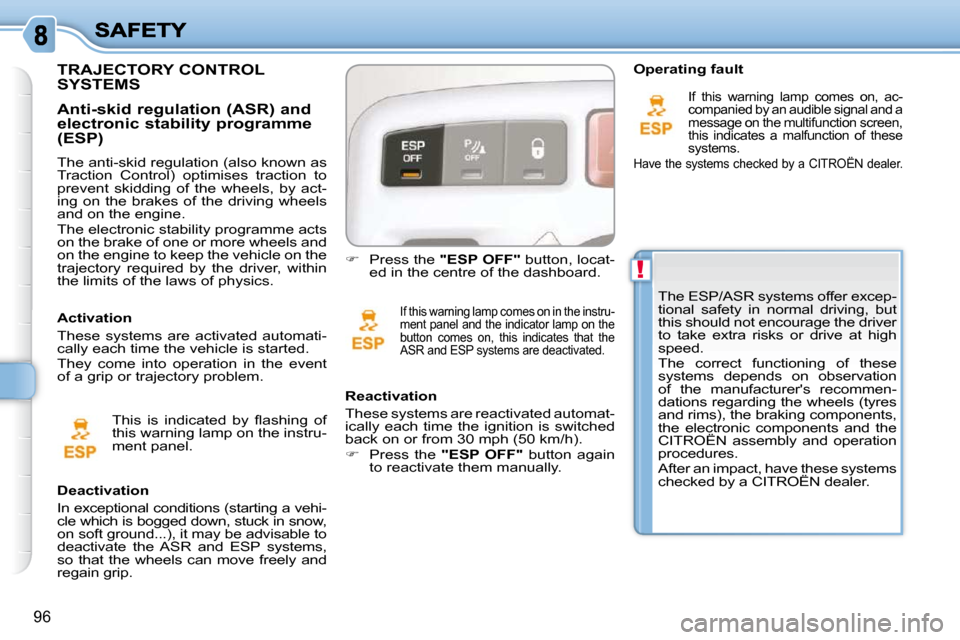
!
96
The ESP/ASR systems offer excep-
tional safety in normal driving, but
this should not encourage the driver
to take extra risks or drive at high
speed.
The correct functioning of these
systems depends on observation
of the manufacturer's recommen-
dations regarding the wheels (tyres
and rims), the braking components,
the electronic components and the
CITROËN assembly and operation
procedures.
After an impact, have these systems
checked by a CITROËN dealer.
Deactivation
In exceptional conditions (starting a vehi-
cle which is bogged down, stuck in snow,
on soft ground...), it may be advisable to
deactivate the ASR and ESP systems,
so that the wheels can move freely and
regain grip.
� Press the "ESP OFF" button, locat-
ed in the centre of the dashboard. If this warning lamp comes on in the instru-
ment panel and the indicator lamp on the
button comes on, this indicates that the
ASR and ESP systems are deactivated.
Reactivation
These systems are reactivated automat-
ically each time the ignition is switched
�b�a�c�k� �o�n� �o�r� �f�r�o�m� �3�0� �m�p�h� �(�5�0� �k�m�/�h�)�.�
� Press the "ESP OFF" button again
to reactivate them manually. Operating fault
If this warning lamp comes on, ac-
companied by an audible signal and a
message on the multifunction screen,
this indicates a malfunction of these
systems.
Have the systems checked by a CITROËN dealer.
TRAJECTORY CONTROL SYSTEMS
The anti-skid regulation (also known as
Traction Control) optimises traction to
prevent skidding of the wheels, by act-
ing on the brakes of the driving wheels
and on the engine.
The electronic stability programme acts
on the brake of one or more wheels and
on the engine to keep the vehicle on the
trajectory required by the driver, within
the limits of the laws of physics.
Anti-skid regulation (ASR) and electronic stability programme (ESP)
� �T�h�i�s� �i�s� �i�n�d�i�c�a�t�e�d� �b�y� �fl� �a�s�h�i�n�g� �o�f�
this warning lamp on the instru-
ment panel.
Activation
These systems are activated automati-
cally each time the vehicle is started.
They come into operation in the event
of a grip or trajectory problem.
Page 112 of 224

98
1. Front and/or rear seat belts not
fastened/unfastened warning lamp.
2. Front left seat belt warning lamp.
3. Front right seat belt warning lamp.
4. Rear right seat belt warning lamp.
5. Rear centre seat belt warning lamp.
6. Rear left seat belt warning lamp.
Seat belt not fastened/unfastened
warning lamp display
Rear seat belts
� �T�h�e� �r�e�a�r� �s�e�a�t�s� �a�r�e� �e�a�c�h� �fi� �t�t�e�d� �w�i�t�h� �a�
three-point inertia reel seat belt with
force limiter (with the exception of the
rear centre seat).
Locking
When the rear side side belts are not being
used, you can lock them in place. To do so:
� Raise the grip A to its maximum
height.
Fastening
� Pull the strap, then insert the tongue
in the buckle.
� Check that the seat belt is fastened
correctly by pulling the strap.
Seat belt unfastened warning lamp
display
When the ignition is switched on, the corre-
sponding warning lamps 4 , 5 and 6 come
�o�n� �i�n� �r�e�d� �f�o�r� �a�p�p�r�o�x�i�m�a�t�e�l�y� �3�0� �s�e�c�o�n�d�s�,� �i�f�
the seat belt is not fastened.
When the engine is running or the vehicle
is moving, the corresponding warning
lamp 4 , 5 or 6 comes on in red, accompa-
nied by an audible signal and a message
on the multifunction screen, if a rear pas-
senger has unfastened their seat belt.
Unfastening
� Press the red button on the buckle.
� Guide the seat belt as it rolls up.
The corresponding warning lamp 2 or 3
comes on in red on the seat belt and
passenger's front airbag warning lamp
display if the seat belt is not fastened or
is unfastened. Seat belt unfastened warning lamp
This warning lamp comes on, either
on the instrument panel or on the
seat belt and passenger's front airbag
warning lamp display, when one or
more rear passengers unfasten their seat belt.
From approximately 12 mph (20 km/h),
�t�h�i�s� �w�a�r�n�i�n�g� �l�a�m�p� �fl� �a�s�h�e�s� �f�o�r� �t�w�o� �m�i�n�u�t�e�s�
accompanied by an audible signal of in-
creasing volume. Once these two minutes
have elapsed, this warning lamp remains
on until the one or more rear passengers
fasten their seat belt.
Page 121 of 224
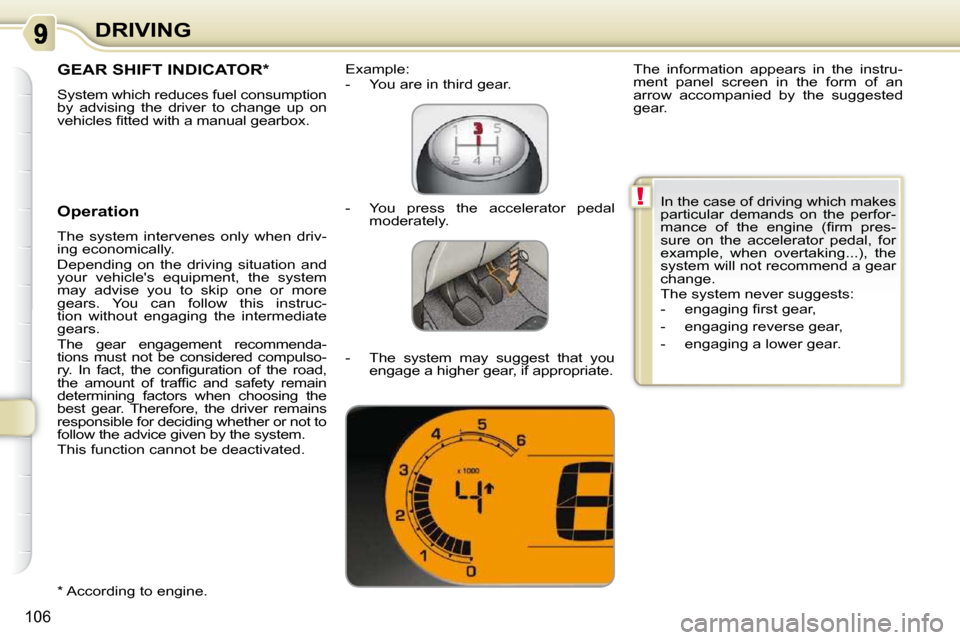
!
106
DRIVING
GEAR SHIFT INDICATOR *
System which reduces fuel consumption
by advising the driver to change up on
�v�e�h�i�c�l�e�s� �fi� �t�t�e�d� �w�i�t�h� �a� �m�a�n�u�a�l� �g�e�a�r�b�o�x�.�
Operation
The system intervenes only when driv-
ing economically.
Depending on the driving situation and
your vehicle's equipment, the system
may advise you to skip one or more
gears. You can follow this instruc-
tion without engaging the intermediate
gears.
The gear engagement recommenda-
tions must not be considered compulso-
�r�y�.� �I�n� �f�a�c�t�,� �t�h�e� �c�o�n�fi� �g�u�r�a�t�i�o�n� �o�f� �t�h�e� �r�o�a�d�,�
�t�h�e� �a�m�o�u�n�t� �o�f� �t�r�a�f�fi� �c� �a�n�d� �s�a�f�e�t�y� �r�e�m�a�i�n�
determining factors when choosing the
best gear. Therefore, the driver remains
responsible for deciding whether or not to
follow the advice given by the system.
This function cannot be deactivated. � � �E�x�a�m�p�l�e�:�
- You are in third gear.
The information appears in the instru-
ment panel screen in the form of an
arrow accompanied by the suggested
gear.
In the case of driving which makes
particular demands on the perfor-
�m�a�n�c�e� �o�f� �t�h�e� �e�n�g�i�n�e� �(�fi� �r�m� �p�r�e�s�-
sure on the accelerator pedal, for
�e�x�a�m�p�l�e�,� �w�h�e�n� �o�v�e�r�t�a�k�i�n�g�.�.�.�)�,� �t�h�e�
system will not recommend a gear
change.
� �T�h�e� �s�y�s�t�e�m� �n�e�v�e�r� �s�u�g�g�e�s�t�s�:�
� � � �-� � �e�n�g�a�g�i�n�g� �fi� �r�s�t� �g�e�a�r�,�
- engaging reverse gear,
- engaging a lower gear.
* According to engine. - You press the accelerator pedal
moderately.
- The system may suggest that you engage a higher gear, if appropriate.
Page 127 of 224
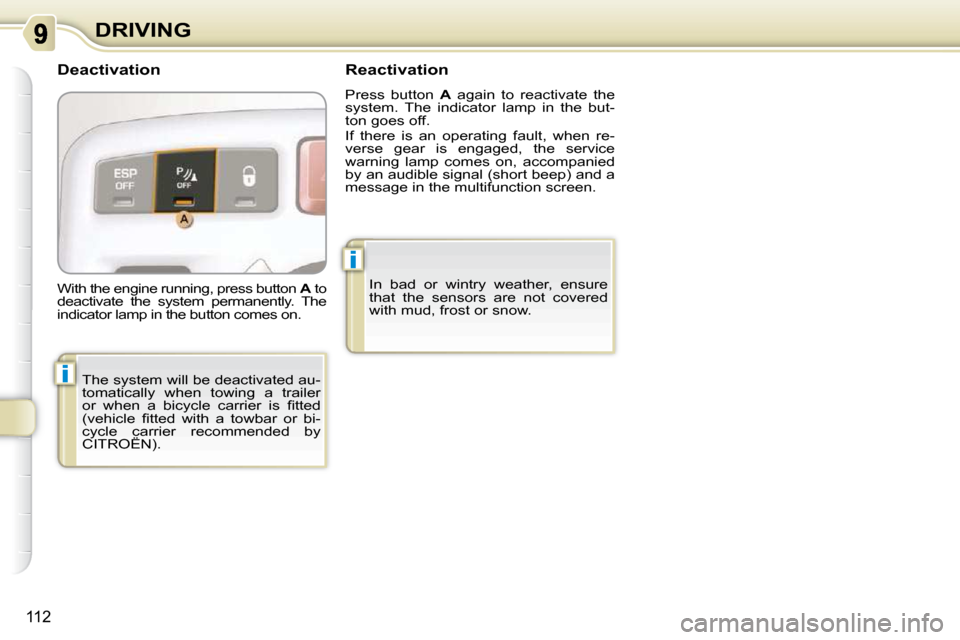
i
i
112
DRIVING
Deactivation
The system will be deactivated au-
tomatically when towing a trailer
�o�r� �w�h�e�n� �a� �b�i�c�y�c�l�e� �c�a�r�r�i�e�r� �i�s� �fi� �t�t�e�d�
�(�v�e�h�i�c�l�e� �fi� �t�t�e�d� �w�i�t�h� �a� �t�o�w�b�a�r� �o�r� �b�i�-
cycle carrier recommended by
�C�I�T�R�O��N�)�.� � Reactivation
Press button
A again to reactivate the
system. The indicator lamp in the but-
ton goes off.
If there is an operating fault, when re-
verse gear is engaged, the service
warning lamp comes on, accompanied
�b�y� �a�n� �a�u�d�i�b�l�e� �s�i�g�n�a�l� �(�s�h�o�r�t� �b�e�e�p�)� �a�n�d� �a�
message in the multifunction screen.
With the engine running, press button A to
deactivate the system permanently. The
indicator lamp in the button comes on. In bad or wintry weather, ensure
that the sensors are not covered
with mud, frost or snow.
Page 128 of 224

i
i
114
CHECKS
BONNET
� Push the exterior safety catch B to
the left and raise the bonnet.
� Unclip the stay C from its housing.
� Fix the stay in the notch to hold the
bonnet open.
Closing
� Take the stay out of the support
notch.
� Clip the stay in its housing.
� Lower the bonnet and release it at
the end of its travel.
� Pull on the bonnet to check that it is
secured correctly.
� Open the front left door.
� Pull the interior bonnet release lever A ,
located at the bottom of the door aper-
ture. The location of the interior bonnet
release lever prevents opening of
the bonnet while the front left door
is closed.
When the engine is hot, handle the
exterior safety catch and the bon-
net stay with care (risk of burns).
Opening
RUNNING OUT OF FUEL (DIESEL)
� �I�f� �y�o�u�r� �v�e�h�i�c�l�e� �i�s� �fi� �t�t�e�d� �w�i�t�h� �a�n� �H�D�I� �e�n�-
gine, the fuel system must be primed if
you run out of fuel.
This system consists of a priming pump
and a transparent pipe under the bonnet.
� � � �F�i�l�l� �t�h�e� �f�u�e�l� �t�a�n�k� �w�i�t�h� �a�t� �l�e�a�s�t� �fi� �v�e� �l�i�-
tres of Diesel.
� Open the bonnet.
� Depending on version, unclip the
cover to gain access to the priming
pump.
� Squeeze and release the priming
pump until resistance is felt (could
�b�e� �f�r�o�m� �t�h�e� �fi� �r�s�t� �a�p�p�l�i�c�a�t�i�o�n�)� �a�n�d� �f�u�e�l�
appears in the transparent pipe with
the green connector.
� Operate the starter until the engine
starts.
� Depending on version, put the cover
back in position and clip it in place.
� Close the bonnet.
If the engine does not start at the
�fi� �r�s�t� �a�t�t�e�m�p�t�,� �d�o� �n�o�t� �t�r�y� �a�g�a�i�n�.�
Operate the priming pump again,
then the starter.
Page 129 of 224
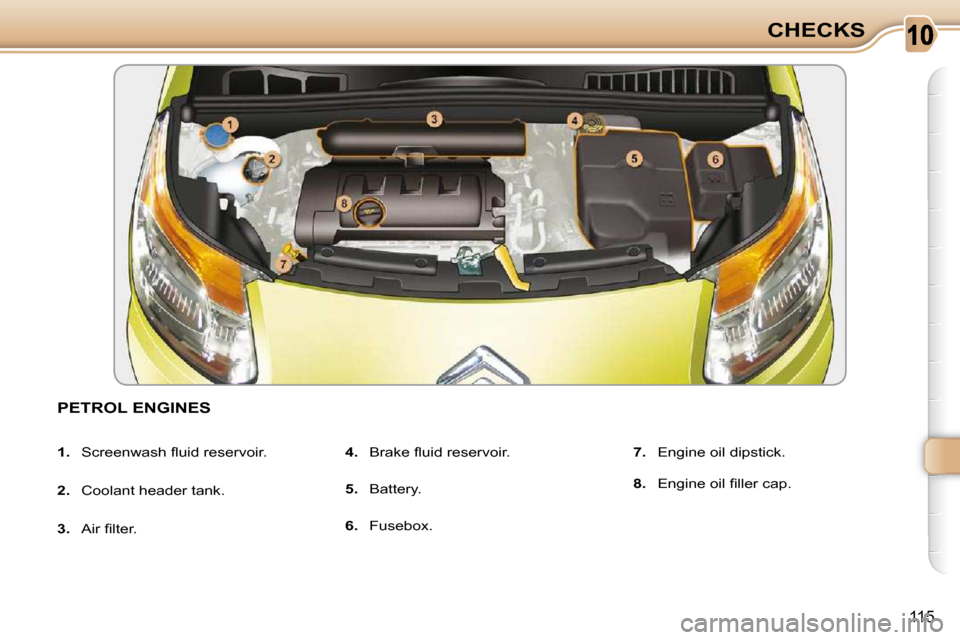
10
115
CHECKS
PETROL ENGINES
1. � � �S�c�r�e�e�n�w�a�s�h� �fl� �u�i�d� �r�e�s�e�r�v�o�i�r�.�
2. Coolant header tank.
3. � � �A�i�r� �fi� �l�t�e�r�.�
4. � � �B�r�a�k�e� �fl� �u�i�d� �r�e�s�e�r�v�o�i�r�.�
5. Battery.
6. Fusebox.
7. Engine oil dipstick.
8. � � �E�n�g�i�n�e� �o�i�l� �fi� �l�l�e�r� �c�a�p�.� �